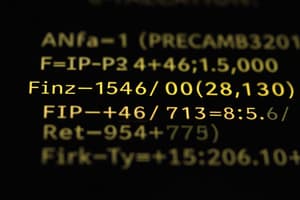Podcast
Questions and Answers
How is the expression AB+CD represented in Reverse Polish notation?
How is the expression AB+CD represented in Reverse Polish notation?
- A*B*CD+
- A*BCD*+
- AB*CD*+ (correct)
- AB*CD+*
What does SIMD represent in computing?
What does SIMD represent in computing?
- Multiple processing units supervised by a common control unit. (correct)
- An organization of a single computer system.
- A system capable of processing several programs simultaneously.
- The collective processing of inputs in a sequential manner.
Which type of number representation is used for storing real integers?
Which type of number representation is used for storing real integers?
- Boolean values
- Whole integers
- Whole numbers
- Floating point representation (correct)
What is a key feature of assembly language compared to machine language?
What is a key feature of assembly language compared to machine language?
What method is commonly used for performing subtraction in computers?
What method is commonly used for performing subtraction in computers?
What does rotational latency refer to in the context of data storage?
What does rotational latency refer to in the context of data storage?
What makes RAM unsuitable for permanent storage?
What makes RAM unsuitable for permanent storage?
What purpose do addressing modes serve in computer systems?
What purpose do addressing modes serve in computer systems?
Flashcards
Reverse Polish notation
Reverse Polish notation
A method of representing mathematical expressions where operators appear after their operands, rather than between them. It's like a postfix notation.
SIMD
SIMD
A computer architecture designed to execute multiple instructions simultaneously. It uses multiple processing units under a single controller, speeding up operations by processing data in parallel.
Floating Point Representation
Floating Point Representation
A representation of real numbers in computers. It allows for storing numbers with both whole and fractional parts.
Assembly Language
Assembly Language
Signup and view all the flashcards
2's Complement
2's Complement
Signup and view all the flashcards
Rotational Latency
Rotational Latency
Signup and view all the flashcards
RAM (Random Access Memory)
RAM (Random Access Memory)
Signup and view all the flashcards
Addressing Modes
Addressing Modes
Signup and view all the flashcards
Flip Flop
Flip Flop
Signup and view all the flashcards
Study Notes
Reverse Polish Notation
- Reverse Polish Notation (RPN) expression for AB+CD is AB*CD*+
SIMD (Single Instruction, Multiple Data)
- SIMD represents an organization where many processing units operate under a single control unit.
Floating Point Representation
- Floating point representation is used to store real integers (numbers with decimal points).
Assembly Language
- Assembly language uses alphabetic codes in place of binary machine language codes.
Subtraction in Computers
- Subtraction in computers is typically performed using the 2's complement method.
Rotational Latency
- Rotational latency measures the time it takes for the desired sector of a hard disk platter to rotate under the read/write head.
RAM Memory
- RAM (Random Access Memory) is volatile memory, meaning its contents are lost when the power is turned off. This makes it unsuitable for permanent storage.
Addressing Modes
- Computers use addressing modes to provide programming flexibility and to modify or interpret the address portion of instructions. These techniques also reduce the number of bits needed for the instructions.
Circuit for Storing One Bit
- A flip-flop is the circuit used to store a single bit of data.
Studying That Suits You
Use AI to generate personalized quizzes and flashcards to suit your learning preferences.




